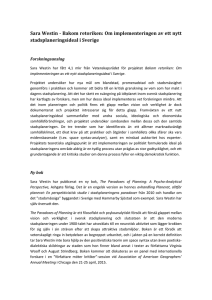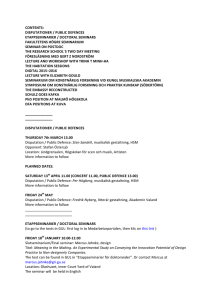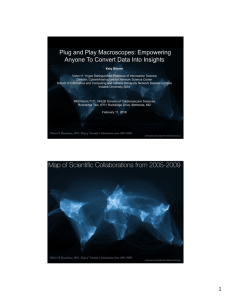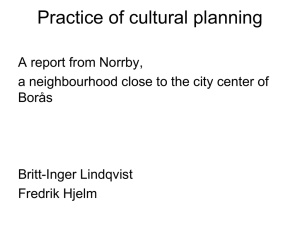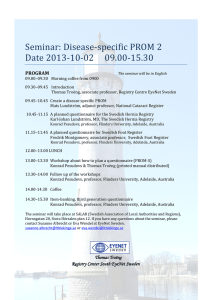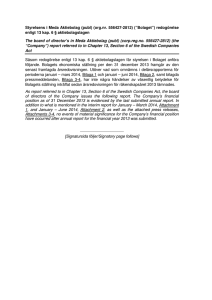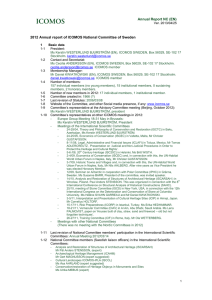INTERFACES 1
advertisement
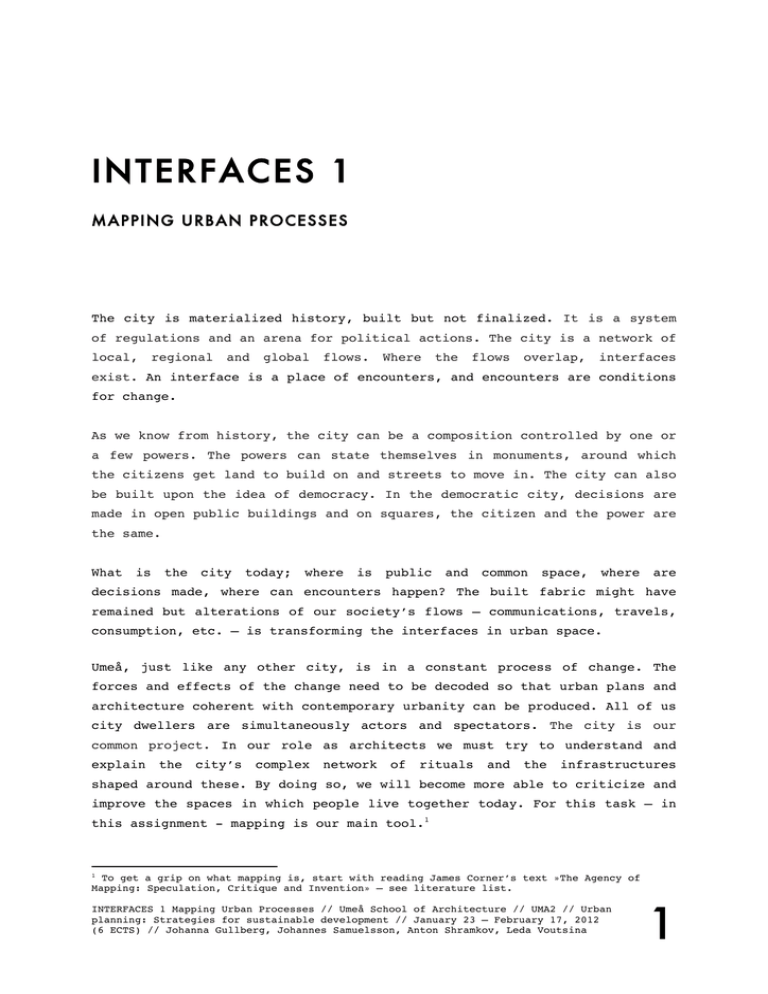
INTERFACES 1 MAPPING URBAN PROCESSES The city is materialized history, built but not finalized. It is a system of regulations and an arena for political actions. The city is a network of local, regional and global flows. Where the flows overlap, interfaces exist. An interface is a place of encounters, and encounters are conditions for change. As we know from history, the city can be a composition controlled by one or a few powers. The powers can state themselves in monuments, around which the citizens get land to build on and streets to move in. The city can also be built upon the idea of democracy. In the democratic city, decisions are made in open public buildings and on squares, the citizen and the power are the same. What is the city today; where is public and common space, where are decisions made, where can encounters happen? The built fabric might have remained but alterations of our society’s flows – communications, travels, consumption, etc. – is transforming the interfaces in urban space. Umeå, just like any other city, is in a constant process of change. The forces and effects of the change need to be decoded so that urban plans and architecture coherent with contemporary urbanity can be produced. All of us city dwellers are simultaneously actors and spectators. The city is our common project. In our role as architects we must try to understand and explain the city’s complex network of rituals and the infrastructures shaped around these. By doing so, we will become more able to criticize and improve the spaces in which people live together today. For this task – in this assignment - mapping is our main tool.1 1 To get a grip on what mapping is, start with reading James Corner’s text »The Agency of Mapping: Speculation, Critique and Invention» – see literature list. INTERFACES 1 Mapping Urban Processes // Umeå School of Architecture // UMA2 // Urban planning: Strategies for sustainable development // January 23 – February 17, 2012 (6 ECTS) // Johanna Gullberg, Johannes Samuelsson, Anton Shramkov, Leda Voutsina 1 The fourth semester at Umeå School of Architecture (UMA) deals with the city. In this course on urban planning, INTERFACES 1, we gather information and make mappings to investigate the concept of cityness and the city of Umeå.2 In the synthesis course (INTERFACES 2) following this planning course, we will make use of our mapping knowledge to understand the flows and boundaries of an airport, and then use the airport as a tool to propose common spaces. The distance from Umeå to the northernmost point of Sweden is 580 kilometers, to Stockholm 650 kilometers, to Moscow 1300 kilometers, to Brussels 1700 kilometers. In 1622 the king of Sweden, Gustav II Adolf, decided to make Umeå a city. In 1652, the city had 200 inhabitants.3 Almost the whole city was destroyed by a fire in 1888. Umeå is today the main city in the Västerbotten region. The area of Umeå municipality is 2400 square kilometers, the area of Västerbotten 115 500. Umeå has 115 000 inhabitants, Västerbotten University, 212 which 000.4 was 40 000 founded European Capital of Culture. 6 Umeå in inhabitants 1965. 5 In study 2014, the or work city at will Umeå be a A long-term goal set by local authorities is that the amount of inhabitants in Umeå should be 200 000 by 2050.7 UMA states that an international airport is a condition for reaching this goal. However, on what basis was the goal of growth set up? By mapping movements, powers and presumptions of Umeå we aim at understanding our city as a process developing over time and as a part of territories larger than itself. We aim at getting an understanding of the elements of the city and the interfaces between these. When the mappings are made, we can critically analyze predictions concerning Umeå’s future and perhaps present alternative ideas. We work within the existing situation; the city does not accept answers from someone who has not listened to it. 2 Cityness is a term used by Saskia Sassen as an alternative to urbanity, which she finds bound to outdated descriptions of cities in the West – see «Cityness in the Urban Age», literature list. 3 See: http://www.umea.se/umeakommun/kommunochpolitik/faktaomkommunen/umeashistoria/ 4 See: http://sv.wikipedia.org/wiki/Umeå 5 See: http://www.umu.se/om-universitetet/ 6 See: http://www.umea2014.se/ 7 See: http://www.umea.se/umeakommun/kommunochpolitik/planerochstyrdokument/kommunalapolicysochprogra m/kommunensmalochverksamhetsdirektiv INTERFACES 1 Mapping Urban Processes // Umeå School of Architecture // UMA2 // Urban planning: Strategies for sustainable development // January 23 – February 17, 2012 (6 ECTS) // Johanna Gullberg, Johannes Samuelsson, Anton Shramkov, Leda Voutsina 2 INTERFACES 1 // CONTENT and LAYOUT This course - Urban planning: Strategies for sustainable development (6 ECTS), «INTERFACES 1 Mapping Urban Processes» - will give different perspectives on the city as reality and concept. It consists of lectures, workshops, a text seminar and project work. The guests invited (see p. 8) represent several disciplines and positions within the urban planning process. The assignment for the project work is described on pp. 5-6 of this document. The list of literature is found on pp. 7-8. Week 01, January 23-27 // INTAKE The concept of mapping. Urban planning ideas and processes. Umeå now and in the past. MONDAY Seminar Room 4, 9-11 am: Introduction - content and layout, guests, assignment. Showcases by Anton Shramkov, Johanna Gullberg, Johannes Samuelsson, Leda Voutsina. Auditorium, 1-3 pm: Roemer van Toorn lectures on mapping - read Corner and Dahlberg to prepare - see literature list. Studio, 3-4 pm: Starter: map yourself in Umeå. TUESDAY Seminar Room 4, 9-11 am, 1-3 pm: Anton, Johanna, Johannes and Leda lecture on urban planning trends during the 20th century: CIAM, Situationism, Datascapes, Jane Jacobs, Gentrification, Soviet planning. Texts related to lectures and texts for seminar on Thursday January 26 introduced - see literature list. WEDNESDAY Seminar Room 4, 9-12 am: Johannes presents his ongoing project about Umeå. Alberto Altés Arlandis lectures on Living Together on the role of architecture in the production of habitable collective spaces. afterwards: time for reading. THURSDAY Seminar Room 4, 9-12 am: Lecture on the notion of urban space by Ola Andersson, architect and critic from Stockholm (founding partner A1 Arkitekter). Lecture on rural versus urban by Madeleine Eriksson, Post Doctor at the department of Social and Economic Geography at Umeå University (PhD 2010, title: “(Re)producing a periphery: popular representations of the Swedish North”). Seminar Room 4, 1-3 pm: groups 1, 2, 4, 5, 7; 3-5 pm: groups 3, 6, 8, 9: text seminar on Umeå history, with tutors, Ola and Madeleine. One student in each group has read one of the texts, see literature list. FRIDAY Auditorium, 8:30-12 am: Olle Forsgren, City Architect in Umeå, presents the municipality’s vision of Umeå’s future. Fredrik Lindegren, head of Umeå 2014, presents Kulturväven. Björn Johansson, Balticgruppen, presents a private interest’s view on the development of Umeå. Auditorium, 1-5 pm: Tomas Strömberg, Head of Planning Department, Umeå kommun, lectures on the Swedish planning process with examples from Umeå, and leads a discussion / workshop on the case of the detailed development plan for the site of Kulturväven. WEEK 02, January 30 – February 3 // FORMATION Mapping references, tools and methods. MONDAY Seminar Room 4, 9-11 am: Anton, Leda and Johanna introduce mapping tools and methods, and ways of presenting planning ideas in graphics. The assignment for weeks 2-4 is introduced. Lecture by Ida Östensson, change maker, on civil dialogue around the skate park in Umeå. afterwards: project work. INTERFACES 1 Mapping Urban Processes // Umeå School of Architecture // UMA2 // Urban planning: Strategies for sustainable development // January 23 – February 17, 2012 (6 ECTS) // Johanna Gullberg, Johannes Samuelsson, Anton Shramkov, Leda Voutsina 3 TUESDAY Computer Lab, 9-10 am: Introduction to map database by students from UMA3. Auditorium, 1:30-2:30 pm: Ann-Sofi Tapani and Berndt Elstig from Bostaden lectures about their projects in Umeå. in between and after: project work, tutorials. WEDNESDAY Auditorium, 9-11 am: Lecture by artist and curator Camilla Påhlsson, Galleri Verkligheten Umeå, on her artistic practice in concerning urban planning processes. afterwards: project work. THURSDAY Seminar Room 4, 9-10:30 am: UMA3 students present mappings they have made (Umeå and Cairo). Erika Henriksson, LiAi, presents her project from the autumn semester 2011. afterwards: project work, tutorials. FRIDAY Seminar Room 3, 10-12 am: groups 1, 4, 7; 1-3 pm: groups 2, 5, 8; 3-5 pm: groups 3, 6, 9 : Pin-up, guest reviewer: Albin Holmgren, architect at White arkitekter Umeå. WEEK 03, February 6-10 // SHIFT In parallel to the project work on Umeå, we shift perspectives by looking to Gothenburg, which – just like Umeå – is building new while branding itself as a city of culture. MONDAY Seminar Room 4, 9-10 am: Anton, Johanna and Leda introduce the remaining part of the assignment. afterwards: project work, tutorials. TUESDAY all day: project work. WEDNESDAY all day: project work, tutorials. THURSDAY Auditorium, 9-11 am: Lecture by Lars Westin, Professor in Economics, head of Centre for Regional Science (CERUM) at Umeå University. Auditorium, 1-3 pm: Lecture by Karl Palmås, sociologist and researcher at Chalmers University of Technology, Gothenburg, on the city from an ontological point of view and an ethnographers perspective. FRIDAY Seminar Room 4, 9-10:30 am: Johannes reads from his work “Att skriva ett modernt äventyr”. Auditorium, 1-4 pm: Lecture by Katarina Despotovic, documentary photographer, Gothenburg, about her work concerning the process of gentrification in Kvillebäcken. Lecture by Carin Malmberg, information officer, Älvstrandens Utveckling AB, on civil dialogue in Gothenburg. WEEK 04, February 13-17 // COMBINATION MONDAY morning & afternoon: project work, tutorials. TUESDAY morning & afternoon: project work, tutorials. WEDNESDAY morning & afternoon: project work, tutorials. THURSDAY morning & afternoon: project work. FRIDAY Auditorium, 9-5 pm: Reviews. Guests reviewers: Karolina Keyzer, City Architect Stockholm, Olle Forsgren, Roemer van Toorn Auditorium, lunchtime: Open lecture by Karolina Keyzer. late afternoon: Opening of exhibition. After the course // EXHIBITION The work produced in the course will be exhibited at UMA until the 1st of March. INTERFACES 1 Mapping Urban Processes // Umeå School of Architecture // UMA2 // Urban planning: Strategies for sustainable development // January 23 – February 17, 2012 (6 ECTS) // Johanna Gullberg, Johannes Samuelsson, Anton Shramkov, Leda Voutsina 4 INTERFACES 1 // PROJECT WORK By mapping Umeå, each group is asked to meet one of three questions, see below. Lectures, seminars and tutorials will guide you. Who owns and who rules the city? 1. Love Brostedt Erik Mårtensson Lisa Nordström Stina Olofsson Fariba Bezaghian MAP The political forces and their representatives. 2. Jacob Edvardsson Rebecka Gunnarsson Julia Samberg Maria Wikström MAP The money and those in charge of it. 3. Annika E.-Lindberg Maja Hallén Gustav Hamlund Nina Larsson Stina Johansson MAP The knowledge capital and its owners. Who moves in, to and from the city – what generates the movements? 4. Kristina Jermer Viktor Johansson Pia Larsson Sofia Pettersson Andreas Sjöberg Karin Stenström MAP Global infrastructure. 5. Miriam Àroch Jonna Ekholm Nina Maanmies Astrid Rosén Hjalmar Stenlund MAP Regional infrastructure. 6. Anna Bygdén Jessica Larsson Rebecka Lind Tove Wennberg MAP Local infrastructure. How is the city perceived and how is it represented? 7. Lotten Drakman Sandra Eliasson Emma Gellerbring Paul Nyrén Sofie Samuelsson MAP The city and nature. 8. Julia Groth Paulina Jaén Edith Steen Alexander Åkerman MAP The city and culture. 9. Miriam Diamant John Grundström Anna Lagercrantz Josephina Wilson (Nils Wållgren) MAP The city and knowledge. The groups dealing with the same topic (1-3, 4-6, 7-9) work in parallel, but should meet and reflect on each other’s material during the process. In the review, the material concerning the same topic should be hung as one composition. Each topic will be reviewed as a whole – the three groups present in a row, and then a longer dicussion follows. INTERFACES 1 Mapping Urban Processes // Umeå School of Architecture // UMA2 // Urban planning: Strategies for sustainable development // January 23 – February 17, 2012 (6 ECTS) // Johanna Gullberg, Johannes Samuelsson, Anton Shramkov, Leda Voutsina 5 In the review, February 17, present your investigations through the following material: One mapping in plan, of a part of the city you find interesting regarding your topic. One mapping in section, a cut through the part shown in the plan. A diary of the process. Could include notes from the group’s meetings and diagrams of the organization of the group as well as more general reflections and sketches in relation to the course. The diary can be a basis for the oral presentations. The two mappings are combinations of several mappings made by you throughout the course. The mappings reveal relationships and structures not obvious at first glance. They can be in any form and material, but has to be represented on 2 landscape A1 sheets. In the pin-up, February 3, present: choice of part of Umeå to map – where and why choice of mapping method/s – what and why first mappings – sketches process diary so far The mappings should include information and interpretations about: The historical process of the city of Umeå in relation to your topic. Which factors have affected the development of the city and in which directions have they lead? Has it been a constant development or have there been gaps and intervals? The contemporary situation in the city of Umeå in relation to your topic. What does the built environment consist of? What kind of activities are taking place in the city and what are the relations between them? How do the inhabitants act as individuals and groups? The decision-making process and the city-mechanism in relation to your topic. Thoughts about future development. Through which processes are decisions taken, and who is taking part in these processes? INTERFACES 1 Mapping Urban Processes // Umeå School of Architecture // UMA2 // Urban planning: Strategies for sustainable development // January 23 – February 17, 2012 (6 ECTS) // Johanna Gullberg, Johannes Samuelsson, Anton Shramkov, Leda Voutsina 6 INTERFACES 1 // LITERATURE and FILM PREPARATION // to read before start of course - Corner, J. ”The Agency of Mapping: Speculation, Critique and Invention”. From Cosgrove, D. (editor). Mappings. 1999. - Dahlberg, G. Hemliga städer : rädslans urbana former. Glänta Hardcore 04. (Om mapping mm.) excerpts FURTHER READING TIPS // in connection to lectures, January 24 - Jacobs, J. The Death and Life of Great American Cities. Introduction. - Mumford, E., Frampton, K. The CIAM Discourse on Urbanism 1928-1960. - Sadler, S. The Situationist City. 1999. Chapter 2: Formulary for a new urbanism: Rethinking the city. - Peck, J. Kreativitet som lösningen på allt. http://www.eurozine.com/articles/2007-06-28-peck-sv.html - Florida, R. The Rise of the Creative Class And How it's Transforming Work, Leisure, Community and Everyday Life. (Read the introduction.) - Amoroso, N. The Exposed City: Mapping the Urban Invisibles. 2010. Chapter 3: The «Datascapes» - The Works of MVRDV. UMEÅ HISTORY // text seminar, January 26 (one text per student in group) - Olofsson, S. I. Umeå stads historia 1888-1972. s. 66-88: Stadens ”livsfrågor” järnväg, farled och regementen. - Olofsson, S. I. Umeå stads historia 1888-1972. s. 575-622, av Eriksson, K.: Stadsplan och bebyggelse i Umeå 1888-1900. - Västerbottens Läns Hembygdsförenings Årsbok, 1922. Abraham Hülphers om Umeå stad, som han besökte år 1758. - Västerbottens Läns Hembygdsförenings Årsbok, 1955. Ahnlund, N.: Västerbotten före Gustav Vasa. - Västerbottens Läns Hembygdsförenings Årsbok, 1959. Cederberg, T.: Umeås väg till akademisk stad. BONUS TEXTS ON UMEÅ // recommendations - Arkitekturguide, Umeå: www.umea.se. - Althén, K. Series of articles about the urban development in Umeå. Autumn 2011, Västerbottens-Kuriren. - Västerbottens Läns Hembygdsförenings Årsbok, 1928. Ask, J. E.: Om staden Umeå. 1731. - Västerbottens Läns Hembygdsförenings Årsbok, 1974. Eriksson, K.: Hus med historia i Umeå. - Västerbottens Läns Hembygdsförenings Årsbok, 1980. Eriksson, K.: Arbetarbostäder, Umeå. - Västerbottens Läns Hembygdsförenings Årsbok, 1981. Eriksson, K.: Byggnadsminnen i Västerbotten. CITY IDEAS // recommendations which we will return to during the semester - Grosz, E. ”Kroppar-städer” (”Bodies-Cities”). From Sexuality and Space. Colomina, B. (editor). 1992. Svensk översättning av Wallenstein, S.-O. i Skriftserien Kairos, nummer 5: Arkitekturteorier. - Koolhaas, R. Generic City. From S, M, L, XL. 1995. - Rowe, C. & Koetter, F. The Collage City (Kollagestaden), 1978. From Hays, M. K. (editor). Architecture Theory since 1968. 2000. Svensk översättning av Fagerström, K. i Skriftserien Kairos, nummer 5: Arkitekturteorier. 1999. - Sennett, R. “The Open City” in The Endless City. Ricky Burdett, Deyan Sudjic (editors). London, New York: The Phaidon Press Ltd, 2007. p. 290-297 especially. - Dialogue Wenders, W. / Kollhoff, H. Staden – Ett samtal (from Quaderns nr 177, 1988, The City. A Conversation, translation Caldenby, C. From Om arkitektur, Caldenby, C. & Nilsson, F. (editors), Arkus, 2002. - Sassen, S. Cityness in the Urban Age. Urban Age, Bulletin 2, Autumn 2005. OVERVIEWS // recommendations - Amoroso, N. The Exposed City: Mapping the Urban Invisibles. 2010. - Hall, P. Cities of Tomorrow: An Intellectual History of Urban Planning and Design in the Twentieth Century. 2002 (1988). INTERFACES 1 Mapping Urban Processes // Umeå School of Architecture // UMA2 // Urban planning: Strategies for sustainable development // January 23 – February 17, 2012 (6 ECTS) // Johanna Gullberg, Johannes Samuelsson, Anton Shramkov, Leda Voutsina 7 - Nyström, J. Planeringens grunder – En översikt. 2003. - Hall, T. & Dunér, K. (red.). Den svenska staden: Planering och gestaltning – från medeltid till industrialism. Sveriges Radios förlag, 1997. At Johanna’s desk. URBAN FILMS // suggestions for evening shows - Monster Cities – Bogotà - Metropolis - Gomorra - Himmel über Berlin (Wings of desire) - City of God - Blade Runner - Koyaanisqatsi INTERFACES 1 // PEOPLE Guests - Ola Andersson, architect and critic, founding partner A1 Arkitekter, Stockholm - Katarina Despotovic, documentary photographer, Gothenburg - Berndt Elstig, property manager, Bostaden, Umeå - Madeleine Eriksson, post doctoral researcher, Department of Social & Economic Geography, Umeå University - Olle Forsgren, City Architect, Umeå - Albin Holmgren, architect, White arkitekter Umeå - Björn Johansson, CEO Balticgruppen Utveckling AB, Umeå - Karolina Keyzer, City Architect, Stockholm - Fredrik Lindegren, head of Umeå 2014 European Capital of Culture, Umeå - Carin Malmberg, information officer, Älvstrandens Utveckling AB, Gothenburg - Karl Palmås, sociologist and researcher at Chalmers Uni. of Technology, Gothenburg - Camilla Påhlsson, artist and curator, Umeå - Tomas Strömberg, head of Planning Department, Umeå kommun - Ann-Sofi Tapani, CEO, Bostaden, Umeå - Lars Westin, Professor in Economics, head of CERUM, Umeå University - Ida Östensson, change maker, Crossing Boarders, Umeå - Students from UMA3 From UMA - Alberto Altés Arlandis, architect and tutor in LiAi Master program at UMA - Johanna Gullberg, architect and tutor (year responsible UMA2) - Erika Henriksson, student in LiAi Master program at UMA - Johannes Samuelsson, artist and guest teacher - Anton Shramkov, architect and tutor - Roemer van Toorn, Professor in Architectural Theory and Media - Leda Voutsina, architect and tutor - Students from UMA3: Albin Grind, Veronika Mikolasevic, Katarina Rohdin, Björn Ylinenpää, Rebecka Örtegren INTERFACES 1 Mapping Urban Processes // Umeå School of Architecture // UMA2 // Urban planning: Strategies for sustainable development // January 23 – February 17, 2012 (6 ECTS) // Johanna Gullberg, Johannes Samuelsson, Anton Shramkov, Leda Voutsina 8
